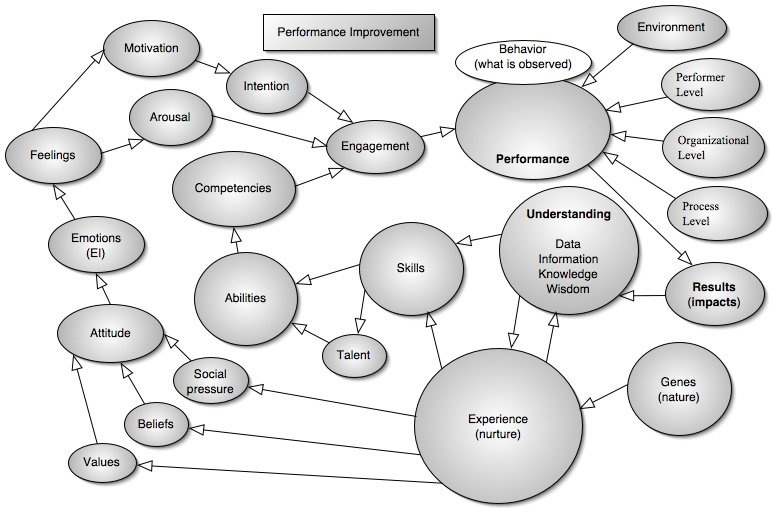Nature and Performance
It is not nature vs. nurture, but rather nature via nurture. That is, our genes cause us to seek out certain environments. For example, being athletic guides one towards a sporting environment, while being intellectual guides one towards a different environment.
Nature and Aging
As we age, the influence of genes increase and the influence of the environment decreases (Ridley, 2003) . The contribution of shared environments to variation in IQ is about 40% in people younger than 20. Conversely, the contribution of genes to explaining variation in IQ rises from 20% in infancy, to 40% in childhood, to 60% in adults, to about 80% in people past middle age. Thus, this kind of explodes the myth that genes influence us early in life and nurture come late.
Nature and Learning
This has some interesting considerations when it comes to learning. As trainers, it would seem at first that we have very little influence with helping a learner to learn since it is not the environment that influences learning, but the genes within the learner. However, the environment of the learner has been chosen by the learner (nature VIA nurture). Thus, the first step when considering a performance intervention is to find the commonalties in the learner's goals and the environment. So the beginning of any change is to ensure that not only does the learner understand the goal of the performance improvement process, but to also ensure that her goal aligns with that of the environment.
The next step is to create learning experiences that allow for errors. Note that it is the errors that cause an action to be produced. That is, we react to our errors. Thus learning is accomplished through trial and error.
In addition to “trial and error,” “we also learn through "gain” — developing greater sensitivity. Trial and error are what we commonly think of as doing, such as practice sessions, while gain is normally accomplished through absorbing, such as reading or listening, reflection, and/or interacting with others.
Genes
A gene is part of a cell that determines which characteristics living things inherit from their parents. Genes determine such features as the shape of a leaf or the sex, height, and hair color of a child. They are like blueprints for building a house, except that they carry the plans for building cells, tissues, organs, and bodies.
The Augustinian monk Gregor Mendel discovered that individual traits are inherited as discrete factors which later became known as genes. Mendel's experiments laid the foundation for the scientific study of heredity, called genetics. In 1865 Mendel reported the results of genetic cross experiments between certain strains of the garden pea. He postulated the principles of inheritance which later became known as “Mendel's laws:”
- Law of segregation: alleles segregate from one another during meiosis (gamete formation). As a result, during meiosis, each gamete has equal chances of obtaining either one of the two alleles present in the parental cell.
- Law of independent assortment: alleles of different, unlinked genes assort independently in meiosis. For example, he showed that the seed texture trait segregated independently of the seed color trait.
- Law of Dominance: alleles can be dominant or recessive. The dominant allele, if present, will always determine the trait.
Definitions
- allele
- 1. Either of a pair of alternative characteristics, such as tallness and dwarfness, potentially present in the germ cell. 2. A gene, especially one gene of a pair that bear these characteristics.
- meiosis
- The process by which the number of chromosomes in reproductive cells of sexually reproducing organisms is reduced to half the original number, resulting in the production of gametes or spores; reduction division. Meiosis consists essentially of two cell divisions. In the first, the homologous chromosomes separate equally into the two new cells so that each contains the haploid number, or half the diploid number. In the second cell division, the pairs of chromosomes split, one of each kind of chromosome going to the four new cells. Thus each new cell again contains the haploid number of chromosomes.
Reference
Matt Ridley (2003). Nature Via Nurture: Genes, Experiences, & What Makes Us Human. New York: Harper Collins Publishers, p. 92.



